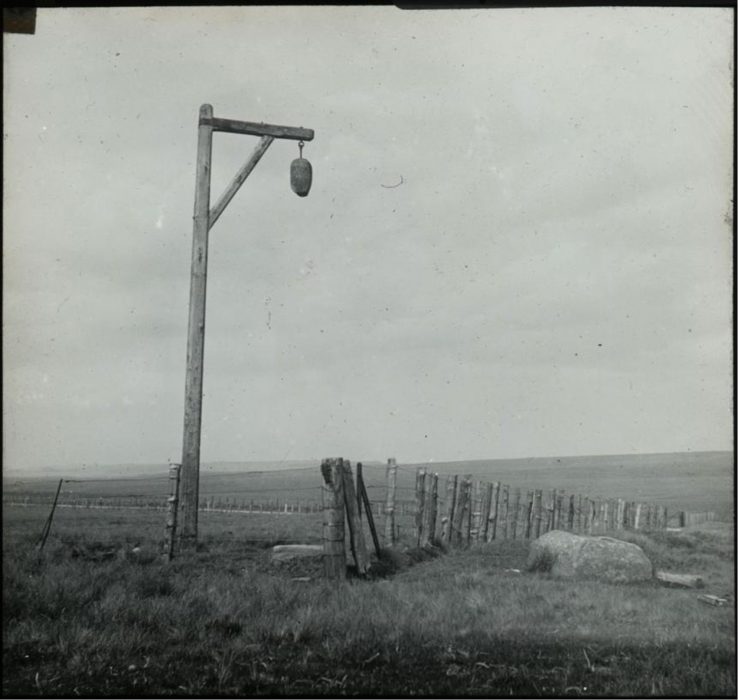Photograph of Winter’s Gibbet
Reference: SANT/PHO/SLI/8/219
Suggested age groups: KS2, KS3, KS4, lifelong learners
Subject areas: History, Biology, Citizenship, Design Technology, Literacy, Art, Maths
CONTEXT
William Winter, along with two female accomplices, was tried and found guilty of the murder of Margaret Crozier of Raw Pele, a hamlet two miles south of Elsdon, on 10 August 1792.
All three were hanged near the site of the crime. The women’s bodies were given over to local physicians. Winter’s body was left to hang from the gibbet until his clothes rotted off. Once his body was cut down, the gibbet remained until weather destroyed the wood. The gibbet has been remade a number of times.
ACTIVITIES
ACTIVITY 1
Background
William Winter, along with two female accomplices, was tried and found guilty of the murder of Margaret Crozier of Raw Pele, a hamlet two miles south of Elsdon, on 10 August 1792. All three were hanged near the site of the crime.
SEE
See: What was William Winter found guilty of?
See: Who were William Winter’s accomplices?
See: Where was Margaret Crozier from?
See: What is a hamlet?
THINK
Think: Why would William Winter and the two women have been hanged near the site of the crime?
Think: Why was William’s body left hanging after his death?
Think: Why would the two women’s bodies be given to physicians after the hanging?
DO
Do: Research why bodies were useful to physicians in the eighteenth century and why the bodies of criminals were used.
Do: Are there ethical issues around using criminals’ bodies for medical research? In groups debate whether or not this was right.
Do: Look on Google Maps: where is Elsdon and Raw Pele? Create a map showing these two places, along with the location of Winter’s Gibbet.
Resources
ACTIVITY 2
Background
William Winter, along with two female accomplices, was tried and found guilty of the murder of Margaret Crozier of Raw Pele, a hamlet two miles south of Elsdon, on 10 August 1792. All three were hanged near the site of the crime.
SEE
See: What material is the gibbet made from?
See: What shapes make up the structure of the gibbet?
See: What is hanging from the gibbet in the photograph? What is it made of?
THINK
Think: How much would it cost to keep replacing Winter’s Gibbet?
Think: Is there a better way that Winter’s Gibbet could be built so that it does not have to keep being replaced?
Think: How could you prevent the head from being stolen from the gibbet?
Think: What other costs would be associated with a hanging?
Think: Should Winter’s Gibbet keep being remade when it falls into disrepair? Should we still commemorate sites and items of capital punishment? Is there something else that could replace it?
DO
Do: Imagine you are remaking Winter’s Gibbet. Make a list of the items that you would need to make it. How much of each item would you need and what would this cost?
Do: Imagine you are remaking Winter’s Gibbet. Make a drawing planning the design of the gibbet. Label your materials and label the size and scale of the drawing.
Do: Create your remaking of Winter’s Gibbet.
Note: If after the final Think point, anyone decides that the gibbet should not be remade, these Do activities could be amended to reflect what they think should stand in its place.
Resources
ACTIVITY 3
Background
William Winter, along with two female accomplices, was tried and found guilty of the murder of Margaret Crozier of Raw Pele, a hamlet two miles south of Elsdon, on 10 August 1792. All three were hanged near the site of the crime.
SEE
See: What is a gibbet?
See: Why was a gibbet used?
See: How were William Winter and the two women executed?
THINK
Think: What is capital punishment?
Think: When was capital punishment used in Britain?
Think: Why was capital punishment used?
Think: Why was capital punishment ended in Britain?
Think: How would William Winter and the two women have been punished if they had committed murder today?
Think: Are there countries that still use capital punishment today?
Think: Is the death penalty ever justified? In pairs or small groups discuss whether or not the death penalty should still be used today. Should it have been used in the past?
DO
Do: Research countries that still use capital punishment today. Create a map of the world showing the countries that still use capital punishment. Create a chart showing how many executions there have been in these countries over the last few years.
Do: Create a piece of argumentative writing arguing either for or against the use of the death penalty. Try to include facts and statistics.
Do: Create a poster arguing either for or against the use of the death penalty.
Do: Should William Winter and the two women have been hanged? As a class or in small groups, role play a trial for the murder of Margaret Crozier. How should the three convicts be punished?
Resources
OTHER ONLINE RESOURCES
Keys to the Past (Northumberland and Durham Historic Environment Record) website, page for Winter’s Gibbet:
http://www.keystothepast.info/article/10339/Site-Details?PRN=N13651
Historic England website, page for Winter’s Gibbet:
https://historicengland.org.uk/listing/the-list/list-entry/1041241
Atlas Obscura website, page for Winter’s Gibbet (includes modern photographs and photograph of plaque at the site):
https://www.atlasobscura.com/places/winter-s-gibbet


